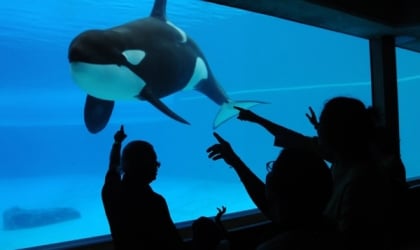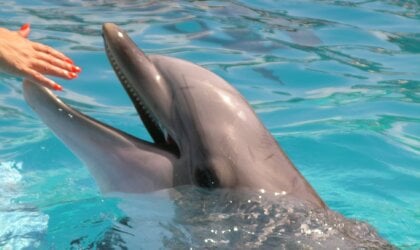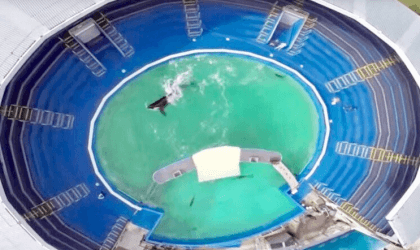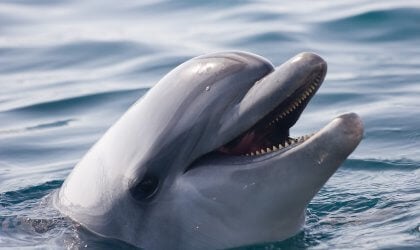In 1969, a pod of orcas off the coast of British Columbia was attacked by humans in boats. The boaters forcibly and violently separated calves from their mothers—a bond that many wild orcas share for life—and sold them into captivity. Corky was one of the young orcas taken that day.
Today, Corky swims in endless circles while locked inside one of SeaWorld’s tiny tanks. Her siblings and other members of her pod still swim free in the ocean, but the only life she knows is one of deprivation, suffering, and loss.

If released to a sanctuary in her home waters, Corky could have an opportunity to communicate with her biological siblings, who traveled with their mother until she passed—an opportunity stolen from her. By listening to the demands of conscientious people around the world and releasing her to a seaside sanctuary, SeaWorld could usher in a new era.
Here are five ways SeaWorld could thrill guests without using Corky or other animals:
1. SeaWorld Could Use Robotic Dolphins and, Eventually, Other Animatronic Cetaceans
Instead of forcing orcas—who can swim up to 150 miles per day in their natural habitats—to be trapped inside tiny tanks and put on shows for humans, SeaWorld could invest in animatronic cetaceans like Delle.
Delle’s creator, Edge Innovations, is working to develop animatronic marine animals that can educate people and offer safe, fun experiences. Ultra-realistic robots like Delle allow humans to interact with lifelike “animals” without the cruelty of keeping any living, feeling beings as prisoners.
Such interactions would still allow humans to learn about the lives of real dolphins and even witness how they move gracefully through the water. The only thing missing would be the suffering!
SeaWorld should work with companies like Edge Innovations to create additional animatronic cetaceans, including orcas and belugas. The parks could offer shows in which these cutting-edge robots swim around and perform while the crowd learns more about real animals’ natural lives. The company’s shows could still include rousing music and a splash zone.
While captive orcas pushed to their psychological limit have injured and even killed human trainers, animatronic ones could enable SeaWorld guests to engage in safe, animal-friendly interactions with these fascinating beings. The parks could even offer people the opportunity to swim safely with robotic orcas or other dolphins.
2. SeaWorld Parks Could Offer Impressive Virtual Reality Experiences
Virtual reality programs—such as PETA’s “I, Orca” or National Geographic’s Encounter: Ocean Odyssey—could allow SeaWorld guests to experience the feeling of swimming free with an orca family in the ocean while remaining firmly on dry land.
Instead of witnessing orcas’ suffering in confinement, guests could appreciate the beauty of these animals’ social connections and feel the excitement of diving to depths of up to 3,500 feet in the open ocean. Virtual reality experiences at SeaWorld could provide humans of all ages with opportunities to learn about Earth’s aquatic ecosystems and how to protect them.
If SeaWorld were to embrace such attractions, its guests could witness the wonders of the ocean and marine animals without anyone being held prisoner.
3. The Parks Could Debut New Motion-Simulator Rides and Attractions
SeaWorld has been investing in new rides that present an opportunity to let Corky and other animals “retire.” Motion simulators—rides where guests sit in seats that move and shake in accordance with a scene unfolding on a screen—could allow guests to follow a pod of “orcas” on thrilling ocean adventures and see stunning visuals of sharks, rays, and other marine animals along the way. This experience could be provided without subjecting a single animal to the stresses of being kept in a marine park.
SeaWorld parks have even featured such attractions in the past, including its “Wild Arctic” rides in Orlando, Florida, and San Diego.
4. The Parks Could Focus On Human Performances and Entertainment
At SeaWorld, orcas like Corky are forced to swim in circles in tanks that are often not even twice as deep as their bodies are long.
An orca living in one of these tanks is like a human living in a bathtub, so SeaWorld should have humans spend their time in bathtubs while others look on. They could perform demeaning tricks for audiences and have their meals brought to them right there in their tubs.
What other thrilling feats could humans perform in SeaWorld shows? The parks could consider adding shows wherein human performers do the following:
- Paddle around its tanks on surfboards while another human stands on top of them
- Swim in a tank while another human holds onto their hair and gets a ride
- Walk around in circles with another human riding on their back
5. SeaWorld Could Have Regular Screenings of the Groundbreaking Film Blackfish
If SeaWorld has nothing to hide, it should let the truth be known. The company should screen the 2013 documentary film Blackfish in its parks.
By doing so, guests could learn about the horrible stress orcas endure in SeaWorld parks and discover the brand’s sordid past deeds—including imprisoning and breeding wild-caught orcas.
Urge SeaWorld to Send Corky to a Seaside Sanctuary
SeaWorld must empty its tanks and release long-suffering animals to seaside sanctuaries, where they could have some semblance of a natural life. Only then will the marine park be an acceptable place to visit with your friends or family.




